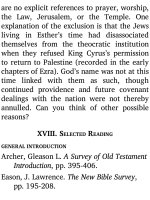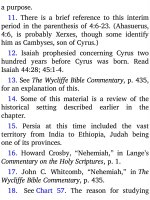Jensens survey of the old testament adam 409
Bạn đang xem bản rút gọn của tài liệu. Xem và tải ngay bản đầy đủ của tài liệu tại đây (144.46 KB, 4 trang )
earthward to ascension heavenward, from
doubt to faith, from life to death. Any
attentive reader of this gospel must be
stirred within as he ponders what its
narrative has to do with him.
E. PURPOSES AND THEME
The three di erent writings of John
(gospel, epistles, Apocalypse [Revelation])
reveal three di erent basic purposes of the
author.
1 . The gospel: the evangelic founding and
nurturing of the church.
2. The epistles: the organic shaping of the
church.
3. The Apocalypse: the eternal future of the
church.6
It is interesting to observe that one author
should be divinely assigned such a wide
range of content for writing.
Chart 41 shows how Christ’s ministry is
written about in each of the three groups of
the New Testament, as well as in the Old
Testament.
John explains speci cally in 20:30-31 why
his gospel was written. It was primarily to
win unbelievers (Jew and Gentile) to a saving
faith. John also must have had in mind the
con rming of believers in their faith,7 so that
the church would have a stronger witness.
Read 20:30-31 for John’s purpose in
reporting the “signs” of Jesus in his gospel.
The miracles were called “signs” by John
because they signified vital spiritual truths.
John wanted his readers not only to learn
those spiritual truths, but to come to a
personal relationship with Jesus through
faith in Him as the Christ, the Son of God.
The theme of his account may be stated as
“Life in Jesus, the Son of God.” Keep in
mind the words believe and life as key words
of John’s gospel. What is the connection
between signs, belief, and life?
CHART 41: CHRIST IN THE BIBLE
John also had other purposes in mind,
subordinate but related to those mentioned
above. One was to refute the heresy of
Docetism, which denied the true humanity
of Jesus (observe John’s “answer” in 1:14).
Another was to expose the unbelief of
Judaism8 (e.g., “He came to his own
country, but his own people did not receive
him,” 1:11, TEV).
F. RELATION TO THE SYNOPTIC9
GOSPELS
The four canonical gospels record an
identical “good news” about the same God-









